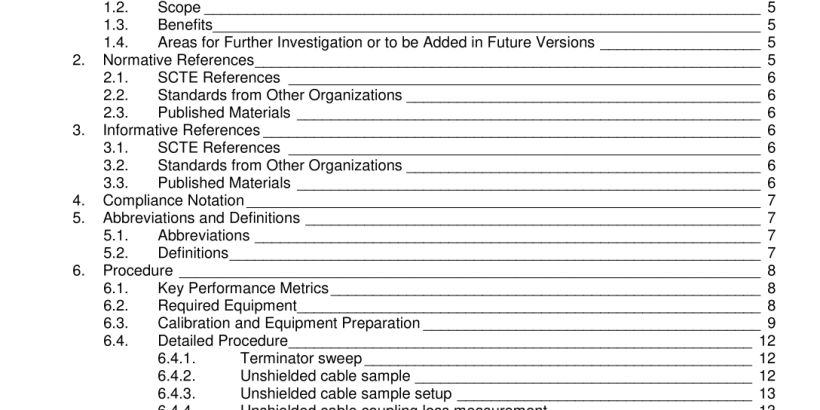ANSI SCTE 48-3-2018 pdf download.Test Procedure for Measuring Shielding Effectiveness of Coaxial Cable and Connectors Using the GTEM Cell
6.4.3. Unshielded cable sample setup
The unshielded cable sample shall be installed within the GTEM cell as shown in Figure 5. The coaxial cable connectors shall be attached to the adapter interfaces on the feed-thru panel located in the center of the GTEM floor (since feed-thru panels are not standard equipment on some models of GTEM cells, holes may be placed on the floor of the GTEM cell centered on the access door and centerline of the cell, and the sample orientation should be in keeping with the diagram in Figure 5. One of the feed-thru adapters will be terminated with a 75 Ohm load and the other will be connected to the test lead that returns to the receiver of the spectrum analyzer or network analyzer (the connections to the feed-thru adapters are interchangeable based on the symmetry of the DUT in the GTEM). For typical adapter feed-thru configurations, refer to Figure 11.
adding attenuation to the system in order to avoid damage to measurement equipment. Perform a coupling loss measurement of the unshielded cable and store the data to be used later for calculating the S.E. of the cable under test, and dynamic range. Figure 6 illustrates a sample coupling loss plot of the unshielded cable under test. This trace is a measurement of the RF voltage loss between the voltage input to the GTEM cell and the voltage coupled by the unshielded cable under test.
6.4.5. Calculation of dynamic range
Recall the stored data from the terminator sweep in a spreadsheet. Then recall the stored data from the unshielded cable coupling loss measurement. Be sure to account for any attenuation that may have been added during the unshielded cable sweep if used. The dynamic range is the difference between the terminator and the unshielded cable measurements. The dynamic range should be 130dB. Figure 6 represents a plot of the unshielded cable and terminator data with dynamic range represented.
NOTE: It may not be possible to remove the jacket of tri-shield cables with bonded outer tapes without damaging the outer tape and invalidating the results. In this case, use method 6.4.6.1. When removing the coaxial cable connectors from the S.E. measurement, the adapter feed-thrus on the GTEM floor, shown in Figure 11, need to be replaced with the appropriate sized cable feed-thru. It is recommended that interchangeable feed-thru panels be used to switch the size of the cable feed-thru. Refer to Figure 12 for a drawing of a typical cable feed-thru. Once the appropriate sized cable feed-thrus are in place, the shielded cable sample shall be installed as shown in Figure 5. The cable feed-thrus are used to clamp around the outer conductor shield of the cable sample where the two-inch sections of jacket have been removed. Note: feedthru design (example Fig 11) is critical to achieving accurate measurements. A perfect R.F. seal is requred to the GTEM floor. Do not use a washer inside the GTEM between the feedthru sealing flange and the floor. Make sure the metal surfaces are bright and clean (no paint or corrosion). In doing this, a 1 meter (3.28 ft) length middle section of the cable sample will remain inside the GTEM cell and the two ends of the cable that are approximately 0.30 m (12 inches) in length will extend outside the GTEM cell through the floor. The cable sample ends shall be terminated similarly to how the unshielded cable sample was terminated in section 6.4.3, however, this sample will be terminated outside the GTEM cell.ANSI SCTE 48-3-2018 pdf download
